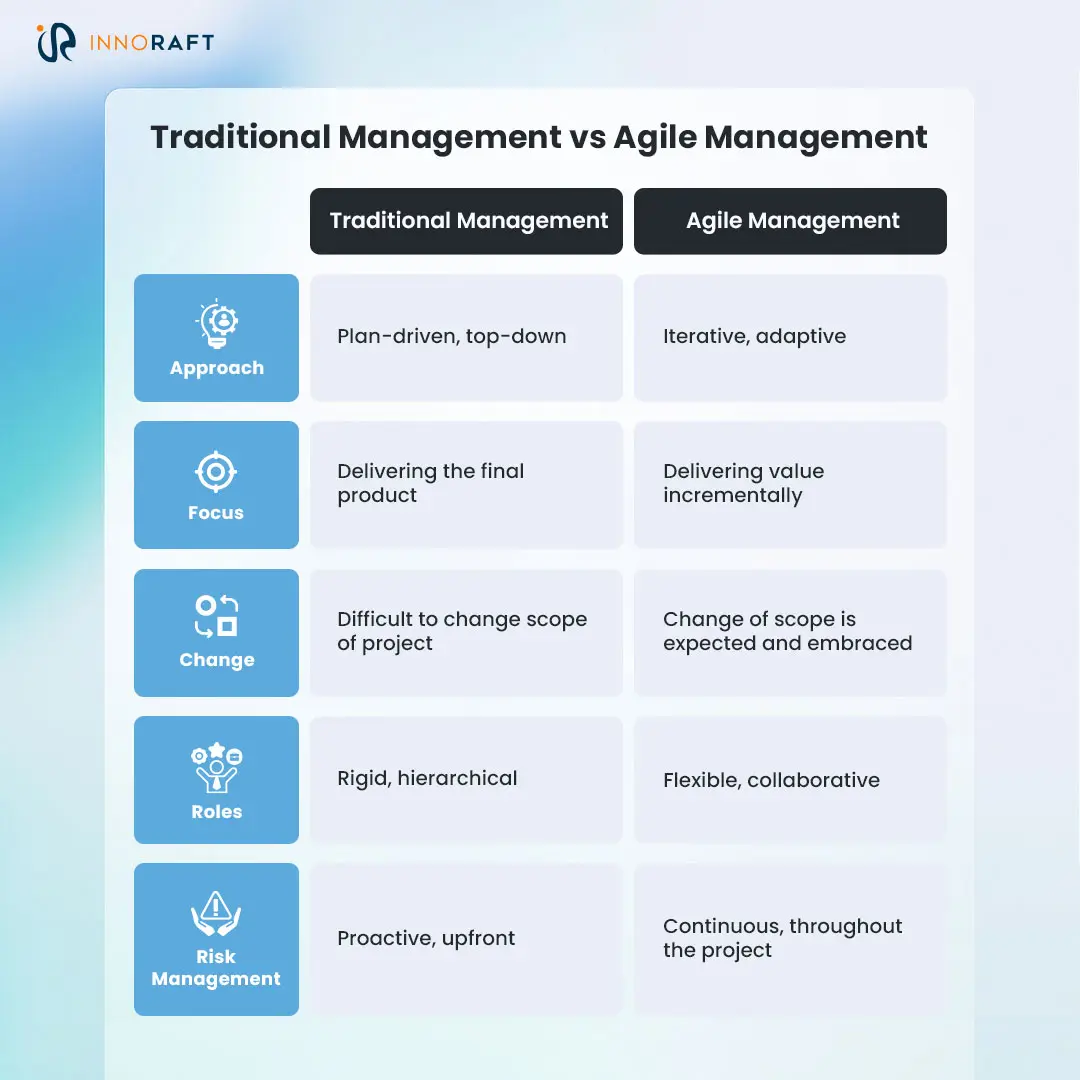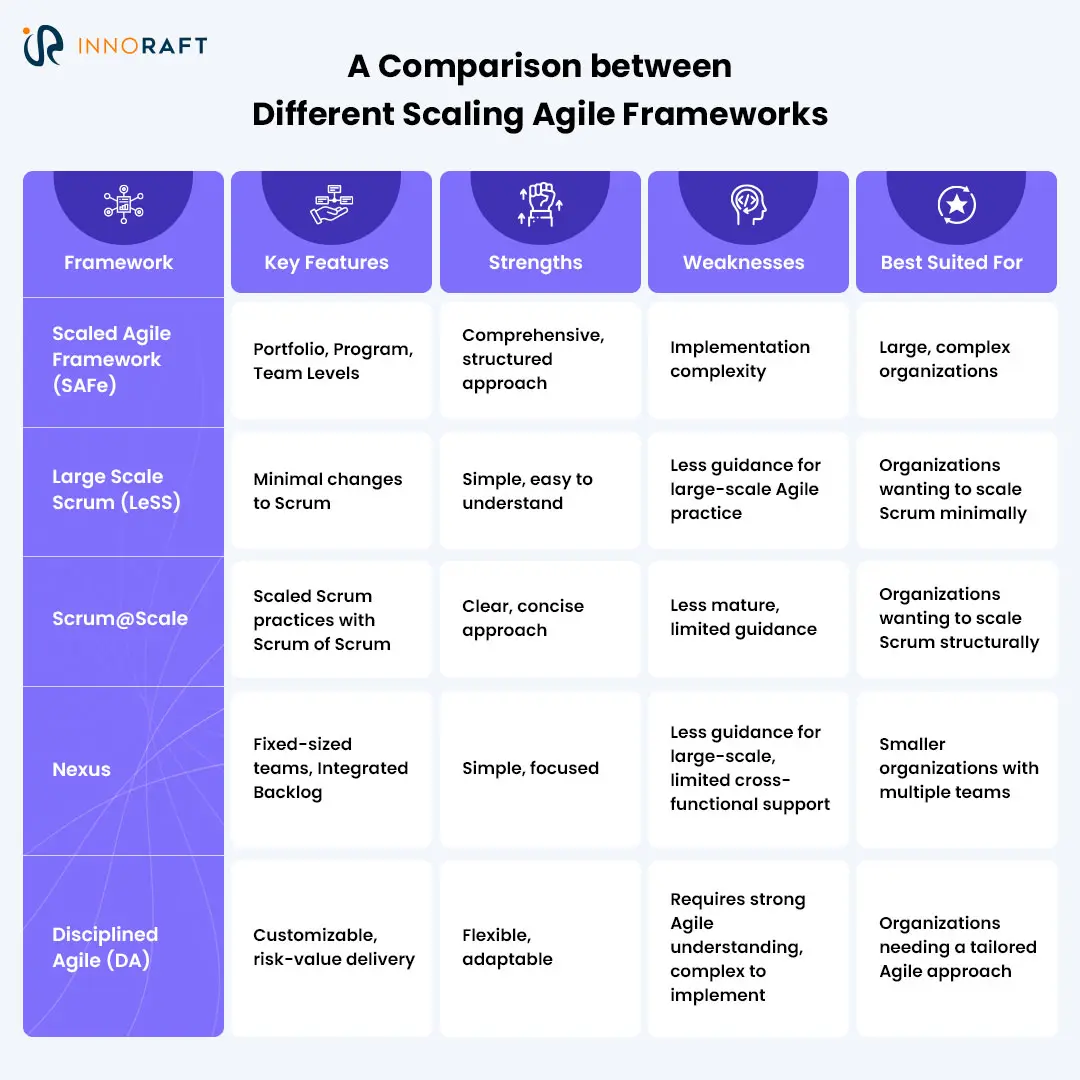Software development used to be a lot different than it is now.
With the traditional Waterfall development, developers had to follow a rigid process. This process required extensive documentation before coding even began and did not allow for any changes in scope or external feedback during the development. Needless to say in a rapidly evolving industry, the Waterfall method proved to be ineffective, producing solutions that were not aligned with the changing requirements of businesses and customers.
To break free from the limitations of the waterfall methods, developers brought forward the Agile Project Management. The core values and principles of the Agile methodology put more emphasis on the people involved, collaborative development, and innovation. This shift in focus resulted in well-aligned, flexible solutions.
The positive results were soon evident: faster development, greater scope of innovation, improved customer satisfaction, better risk management, higher flexibility and adaptability, faster time to market, and solutions aligned with the changing market demands. Witnessing these benefits, business leaders soon wondered if Agile methodologies could be applied across organizations to enhance business agility.
Agile Transformation in Business: A Trend or Meaningful Initiative?
To understand whether you can apply Agile at scale for your businesses or not, we must first understand what Agile means.
It is not just a collection of processes or methods. Agile is a mindset that allows dynamic teams to collaborate and work towards a shared goal. This mindset is further defined by four core values of Agile:
- Individuals Over Processes or Tools: Collaboration and teamwork are more important than working by the book.
- Working Solution Over Comprehensive Documentation: Delivering a functional solution takes precedence over fulfilling stringent documentation requirements.
- Customer Collaboration Over Contract Negotiation: Customers should be the ones guiding where the software goes, putting importance on customer collaboration.
- Responding to Changes Over Following A Plan: Teams need to be able to rapidly shift strategies and workflows to align with constant changes without losing sight of business goals.
The Agile Project Management values make it evident where the real importance lies; in the collaborative creation of working solutions through a process that allows for changes in scope, holds customer feedback in high esteem, and leaves room for innovation.
Now the question is, can you apply this across your entire business operation? And is it worth the effort?
The answer is yes. Though the transformation is difficult and time consuming, the benefits make the whole process worth it. The positive impact of scaling Agile practices across the business, includes increased efficiency and productivity, greater adaptability, improved quality and innovation, and a boost in employee performance to streamline business processes, promoting greater trust and transparency.
However, Agile transformation for business is not without its challenges. While transforming the existing operations, you will face significant cultural, technological and framework challenges. Let us examine these challenges in depth to understand how you can solve them.
The Challenge of Scaling Agile Practices
To ensure the success of Agile implementation, the organization must pivot away from how it functions. Your business will require a complete shift in how teams think, work, and innovate collaboratively. In short, you will need to challenge the status quo of business operations.
The Challenge of A Cultural Shift
The first significant challenge of scaling Agile practices lies in the mindset of people working in the company. Enterprises often follow a hierarchical structure, where top management determines the business goals, and employees are expected to execute these directives. This approach lacks autonomy and ownership, stifling innovation and limiting the potential of employee-driven initiatives.

The existence of silos can further complicate the cultural shift challenge. Teams working in isolation cannot communicate or share feedback and ideas freely, preventing them from becoming dynamic and cross-functional. To enhance business agility, you must start by eliminating the mindset challenge and fostering a culture of collaboration that prioritizes flexibility, adaptability, and delivering value consistently.
The Technology Shift
The second challenge you will face during Agile transformation is the technology challenge. This challenge centers around processes, tools, and technologies. Traditional workflows often rely heavily on siloed teams and technologies. This reliance on outdated technology can hinder the development of a collaborative and transparent work environment.

You must invest in modern technologies to implement Agile at scale for your business. Your teams will need tools that promote greater visibility and collaboration and offer a unified view of deliverables, task progress, and open communication channels. This technology shift is essential to enhance the operational agility of your organization.
The Framework Challenge
For big enterprises, the original Agile methods might not be the right fit. Such organizations require comprehensive frameworks that can fulfill the complex flexibility and transparency requirements and address the business agility challenges.

Fortunately, several Agile frameworks such as The Scaled Agile Framework (SAFe), Large Scale Scrum (LeSS), Agile@Scale have emerged recently in the industry. These frameworks can help you effectively address the challenges of scaling Agile practices for your large organizations. You can build a new framework exclusive to your organization or adopt any of these existing frameworks based on your organizational requirements .
If you are thinking of adapting one of the existing frameworks, you must understand whether these are right for your business. Here’s a breakdown of these frameworks and whether they will suit your business needs.
Comparing Leading Agile Scaling Frameworks
There’s no one-size-fits-all solution when it comes to scaling Agile. There are various frameworks, and each offers you different approaches to help your organization grow and become more Agile.
But how do you know which is the best fit for your organization?
Let us explore some of the most popular scaling Agile frameworks to get a better understanding.
Scaled Agile Framework (SAFe)
The Scaled Agile Framework (SAFe) is a comprehensive framework for scaling Lean-Agile practices across large enterprises. The framework offers you a guided approach to implementing Agile across business operations based on the knowledge of Agile development, Lean product development, and systems thinking. With SAFe implementation, you can focus more on aligning teams, promoting collaboration, and delivering values consistently.
SAFe offers four levels of configurations to suit different levels of scale. These configurations help you customize your approach to scaling Agile for your business. These configurations are:
Essential SAFe:
It is the foundational level of SAFe and focuses on the core principles of Lean-Agile practices. This configuration enables teams to work together effectively, constantly delivering value.
Large Solution SAFe:
Large Solution SAFe is designed for more complex projects and operations. It helps to add more tools and resources to help teams collaborate effortlessly.
Portfolio SAFe
Portfolio SAFe is centered around planning and decision-making for the whole organization, offering roadmaps for the company and determining future goals.
Full SAFe:
As the most comprehensive configuration, full SAFe combines all the other levels, bringing together all the tools and resources to enhance business agility.
If there are some pockets within your organization where Agile Project Management already exists, the SAFe is a great choice for you. It will help to scale the existing Agile practices across the business, bringing forth a comprehensive transformation.
Large Scale Scrum (LeSS)
Large Scale Scrum (LeSS) applies the simplicity of Scrum to larger enterprises and operations. With this framework, you can start with one Scrum team and then scale up by adding more teams to work on a single solution. It is a minimalist framework, simplifying the process of scaling Agile practice across your business. The straightforward nature makes it ideal for businesses looking for a lightweight approach to scaling Agile. If your organization already has a foundation in Scrum, then LeSS is the best choice for your business.
Scrum@Scale (SaS)
If your organization uses Scrum methods, then Scrum@Scale will be an easy transition for you. The framework leverages components such as Scrum of Scrum (SoS), where each team selects a representative for a regular coordination meeting among different teams. These meetings are held after each team’s daily standups to ensure clear communication among the teams and alignment with the big-picture goals. Scrum@Scale also introduces some unique roles, such as the SoS Master, a scaled version of Scrum Master, as well as the Chief product owner, who is in charge of a joint backlog for multiple teams. This is the right framework for you if you are looking for a familiar yet scalable structure.
Nexus
As a lightweight framework to implement Agile at Scale for businesses, Nexus leverages Scrum’s simplicity, adding structure to make it functional for multiple teams. Designed for smaller groups of three to nine teams, Nexus doesn’t require any additional roles. Rather, one representative from each team joins a central integration team to align their work and collaborate effortlessly.
If you are looking for a streamlined solution to enhance business agility, then Nexus is a good fit. Teams within your organization can work together on sprint planning, and integration teams can check in daily to track progress and hold refinement sessions to manage complexity as the project evolves.
Disciplined Agile (DA)
Unlike the other scaling Agile frameworks, Disciplined Agile (DA) is more of a toolkit than a full-fledged framework. It offers a plethora of strategies that you can tailor to your organization’s Agile transformation needs. DA combines all the elements from Scrum, Kanban, and other Lean-Agile Practices, enabling you to pick and choose what works best to enhance your organization’s agility. DA can support the full lifecycle of a project- from ideation to solution release and introduces roles like Team Lead, Product Owner, and Architecture Owner. If you need a flexible, context-driven approach to scale Agile across your business, DA can be the best choice.
Each of these frameworks offers unique strengths and weaknesses. The best fit among these frameworks, however, depends on your business’s specific requirements. So, before you choose one framework, analyze key factors, such as the organization's size, operational complexity, and goals. This analysis will help you choose the right framework to enhance operational agility.
Best Practices for Scaling Agile
Scaling Agile practices is all about thoughtfully aligning your organization with the Lean-Agile practices. Such transformations requires you to carefully balance the cultural, technical, and mindset shifts. Here are some best practices that can help you to successfully scale Agile practices across your business:
Align Agile with Business Strategies
Ensure your Agile transformation initiatives are aligned with your company’s strategic objectives. This way, everyone within the organization can collaboratively work toward the same deliverables and outcomes that matter for your organization.
Empower Teams
Agile is all about people over processes. Foster a culture that offers your employees all the tools, flexibility, and trust to innovate and solve problems. Giving people ownership over their work will motivate them to deliver high-quality results.
Define Roles and Responsibilities
When implementing Agile at scale, make sure everyone knows what role they are supposed to play and how they will be contributing to the larger picture. This clarity about roles and responsibilities will remove any confusion, keep processes running smoothly, and ensure accountability.
Measure and Adjust
Agile is all about constant improvements, so it is important to regularly measure your progress. Determine the right metrics and use them to track performance, delivery time, and customer satisfaction. Based on these measurements, you need to adjust your approach, keeping Agile practices effective at scale.
Conclusion
In the constantly evolving world of business, staying Agile while growing is the key to unlocking accelerated innovation, improved productivity, and enhanced customer satisfaction. Scaling Agile practices across businesses allows your team to follow the same roadmap, remain aligned with one another, and constantly deliver value. For larger organizations, it brings clarity and flexibility, offering more room for growth.
Despite the benefits, however, scaling Agile is not an easy transition. It requires a deep commitment to all things Agile. You need to invest time and resources to train teams, adjust workflows, and keep everyone on the same page. Though the transition is tough, it can be significantly transformative. Agile transformation can help you remove the bottlenecks of traditional business operations, augment transparency and trust, and ensure your organization can move forward with the speed and agility of a fast-growing startup.

